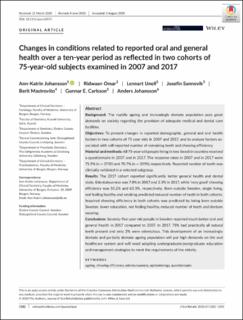| dc.contributor.author | Johansson, Ann-Katrin Gerd | |
| dc.contributor.author | Omar, Ridwaan | |
| dc.contributor.author | Unell, Lennart | |
| dc.contributor.author | Mastrovito, Berit | |
| dc.contributor.author | Carlsson, Gunnar E. | |
| dc.contributor.author | Johansson, Anders Arne | |
| dc.contributor.author | Sannevik, Josefin | |
| dc.date.accessioned | 2021-05-27T10:33:41Z | |
| dc.date.available | 2021-05-27T10:33:41Z | |
| dc.date.created | 2021-01-12T16:26:14Z | |
| dc.date.issued | 2020 | |
| dc.identifier.issn | 0305-182X | |
| dc.identifier.uri | https://hdl.handle.net/11250/2756597 | |
| dc.description.abstract | Background
The rapidly ageing and increasingly dentate population puts great demands on society regarding the provision of adequate medical and dental care facilities.
Objectives
To present changes in reported demographic, general and oral health factors in two cohorts of 75 year olds in 2007 and 2017, and to analyse factors associated with self-reported number of remaining teeth and chewing efficiency.
Material and methods
All 75-year-old people living in two Swedish counties received a questionnaire in 2007 and in 2017. The response rates in 2007 and in 2017 were 71.9% (n = 3735) and 70.7% (n = 5091), respectively. Reported number of teeth was clinically validated in a selected subgroup.
Results
The 2017 cohort reported significantly better general health and dental state. Edentulousness was 7.8% in 2007 and 2.3% in 2017, while ‘very good’ chewing efficiency was 55.2% and 60.5%, respectively. Born outside Sweden, single living, not feeling healthy and smoking predicted reduced number of teeth in both cohorts. Impaired chewing efficiency in both cohorts was predicted by being born outside Sweden, lower education, not feeling healthy, reduced number of teeth and denture wearing.
Conclusions
Seventy-five-year-old people in Sweden reported much better oral and general health in 2017 compared to 2007. In 2017, 75% had practically all natural teeth present and only 2% were edentulous. This development of an increasingly dentate and partially dentate ageing population will put high demands on the oral healthcare system and will need adapting undergraduate/postgraduate education and management strategies to meet the requirements of the elderly. | en_US |
| dc.language.iso | eng | en_US |
| dc.publisher | Wiley | en_US |
| dc.rights | Attribution-NonCommercial-NoDerivatives 4.0 Internasjonal | * |
| dc.rights.uri | http://creativecommons.org/licenses/by-nc-nd/4.0/deed.no | * |
| dc.title | Changes in conditions related to reported oral and general health over a ten-year period as reflected in two cohorts of 75-year-old subjects examined in 2007 and 2017 | en_US |
| dc.type | Journal article | en_US |
| dc.type | Peer reviewed | en_US |
| dc.description.version | publishedVersion | en_US |
| dc.rights.holder | Copyright 2020 The Authors. | en_US |
| cristin.ispublished | true | |
| cristin.fulltext | original | |
| cristin.qualitycode | 2 | |
| dc.identifier.doi | 10.1111/joor.13073 | |
| dc.identifier.cristin | 1870062 | |
| dc.source.journal | Journal of Oral Rehabilitation | en_US |
| dc.source.pagenumber | 1382-1393 | en_US |
| dc.identifier.citation | Journal of Oral Rehabilitation. 2020, 47 (11), 1382-1393. | en_US |
| dc.source.volume | 47 | en_US |
| dc.source.issue | 11 | en_US |

